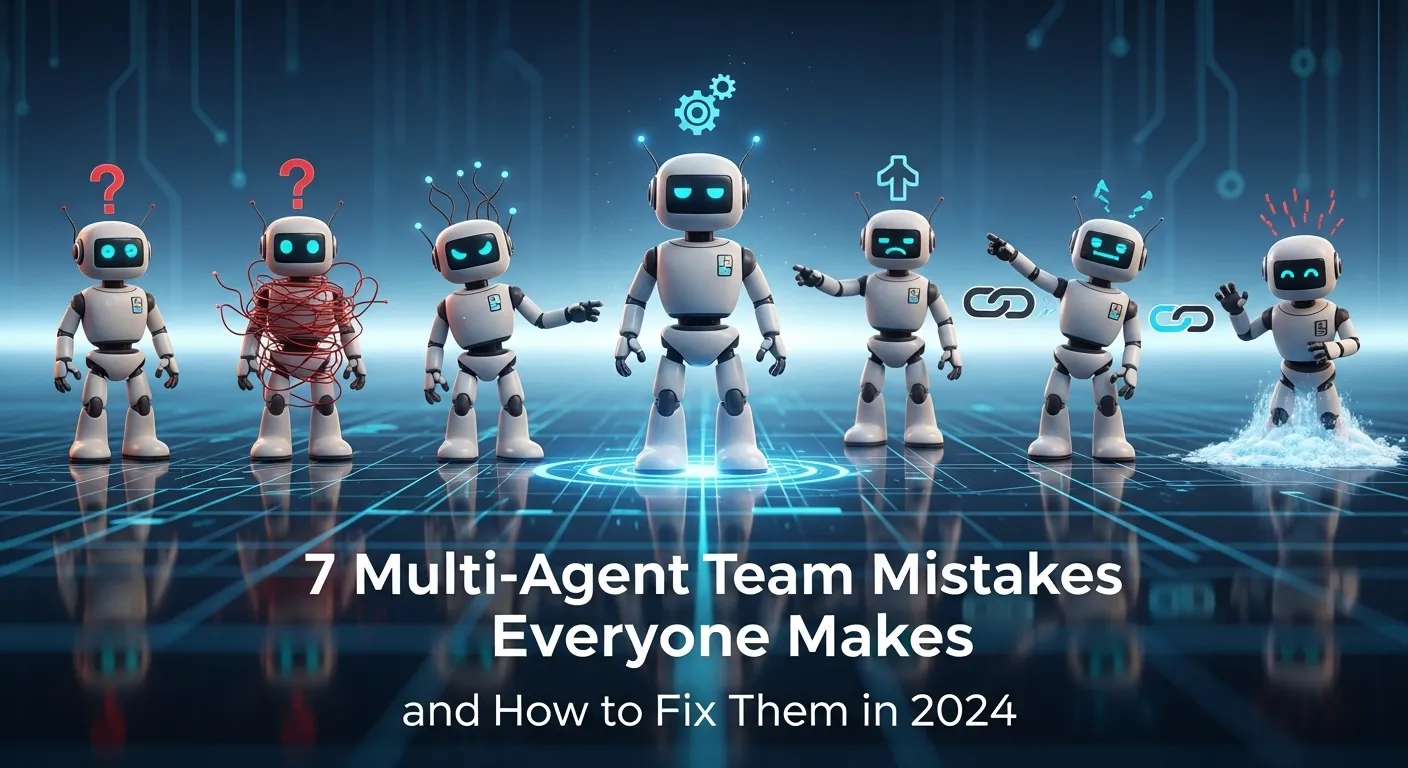You’ve assembled your AI dream team—specialists ready to tackle complex tasks. But instead of seamless collaboration, you get chaos, miscommunication, and wasted resources. Sound familiar? You’re not alone. Here’s how to diagnose and fix the most common multi-agent team failures.
What Are Multi-Agent Teams?
Think of multi-agent teams as your specialized workforce—multiple AI agents, each with distinct roles (researcher, writer, analyst, coder), working together to complete complex tasks that a single agent couldn’t handle alone. It’s like having a well-oiled machine where each cog has a specific job, but when one cog slips, the whole system grinds to a halt.
Mistake #1: The Role Confusion Trap
The most fundamental error? Vague job descriptions. When agents don’t know their exact responsibilities, they either step on each other’s toes or leave critical tasks undone. Your “research agent” might start writing conclusions while your “writer agent” attempts data analysis, creating duplicated effort and conflicting outputs.
Mistake #2: Communication Breakdown
Agents shouting into the void instead of having structured conversations. Without clear communication protocols, your team becomes a group of brilliant individuals working in isolation. They might use different data formats, miss critical updates, or fail to share progress effectively, leading to inconsistent results and workflow bottlenecks.
Mistake #3: No Clear Orchestration
Who’s the conductor of this orchestra? Without proper orchestration, your agents operate like musicians playing different songs simultaneously. The absence of a central controller means no one manages dependencies, timelines, or handoffs between agents, causing projects to derail at the first complexity.
Mistake #4: Ignoring Resource Management
Every agent consumes computational resources. Running multiple agents without monitoring their resource usage can lead to astronomical API costs, slow performance, or even system crashes. It’s like hiring a team of experts but forgetting to budget for their tools and workspace.
Mistake #5: Poor Error Handling
What happens when one agent fails? Most teams lack robust error recovery mechanisms. A single agent error can cascade through the entire workflow, corrupting outputs and wasting previous work. Without proper fail-safes, your entire operation becomes fragile and unpredictable.
Mistake #6: Testing Too Little, Too Late
Deploying complex multi-agent systems without thorough testing is like launching a rocket without checking the fuel lines. Teams often test individual agents but neglect to test their interactions, leading to unexpected conflicts and integration issues that only appear in production.
Mistake #7: Scaling Without Strategy
More agents must equal better results, right? Wrong. Adding agents without considering team dynamics creates coordination overhead that can outweigh any benefits. It’s the classic “too many cooks” scenario, where complexity grows exponentially with each new team member.
Practical Fixes & Best Practices
- Define Crystal-Clear Roles: Create detailed agent personas with specific responsibilities, input requirements, and output expectations. Document everything.
- Establish Communication Protocols: Implement structured data formats, set up message queues, and define handoff procedures between agents.
- Implement Smart Orchestration: Use dedicated orchestrator agents or frameworks to manage workflows, dependencies, and timing.
- Monitor Resources Religiously: Set up cost tracking, implement usage limits, and optimize agent selection based on task complexity.
- Build Robust Error Handling: Create fallback mechanisms, implement validation checks, and design workflows that can recover from partial failures.
- Test Interactions Thoroughly: Run integration tests simulating real-world scenarios before deployment.
- Scale Strategically: Add agents only when necessary, and consider whether simpler solutions might work better.
FAQs
How many agents should my team have?
Start small—2-3 well-defined agents—and only add more when you’ve mastered their coordination. Complexity grows faster than team size, so less is often more.
What’s the biggest cost surprise with multi-agent teams?
API usage spikes from agents calling each other repeatedly or getting stuck in loops. Always implement usage limits and monitoring from day one.
Can I use existing frameworks for multi-agent teams?
Absolutely. Frameworks like AutoGen, CrewAI, and LangGraph provide built-in patterns for agent communication and orchestration, saving you from reinventing the wheel.
How do I know if my multi-agent team is working effectively?
Track completion rates, error frequency, time-to-completion, and resource usage. Effective teams show consistent performance with minimal manual intervention.
Bottom Line
Multi-agent teams represent the next evolution in AI productivity, but they require careful design and management. By avoiding these common mistakes and implementing the fixes we’ve covered, you can transform your chaotic AI collective into a well-oiled machine that delivers consistent, reliable results. Remember: the goal isn’t more agents—it’s smarter coordination.

